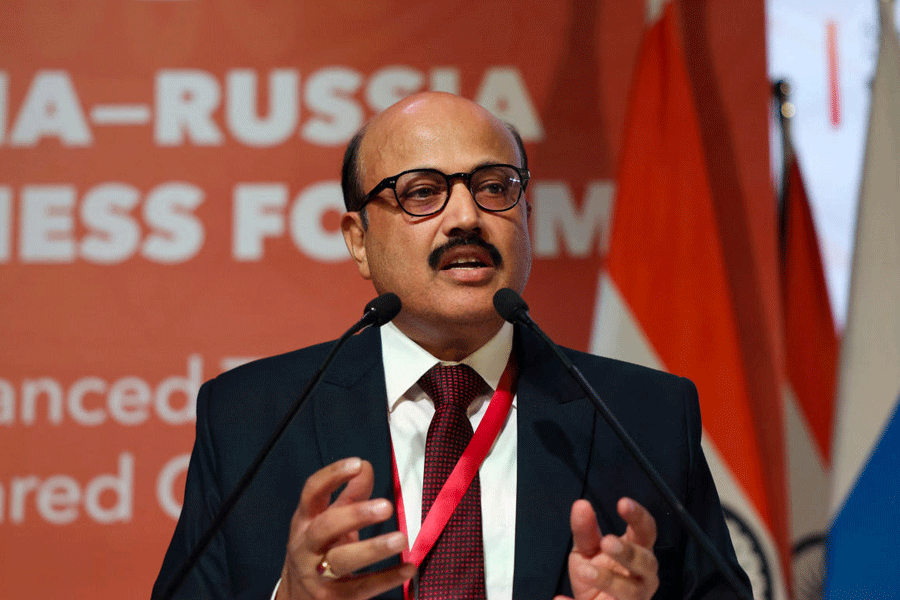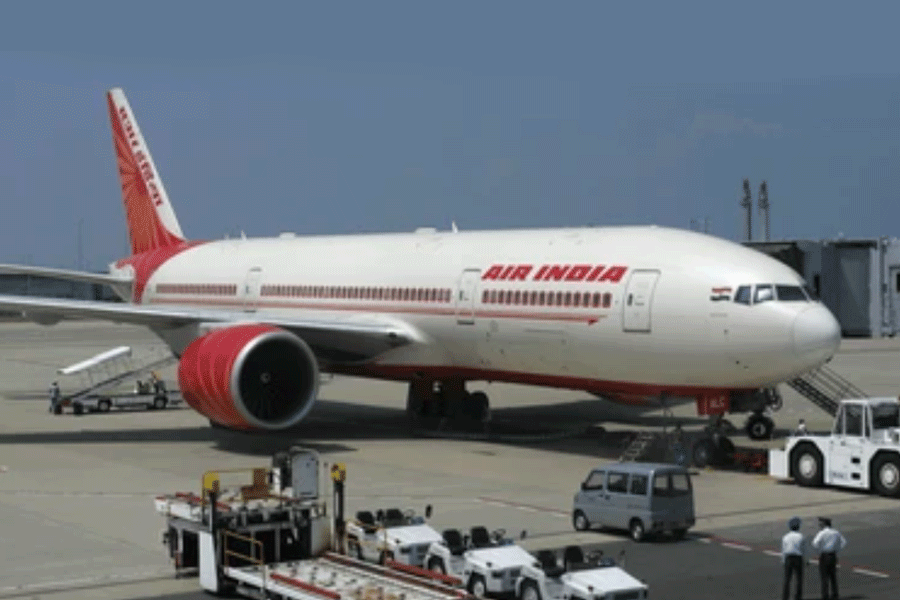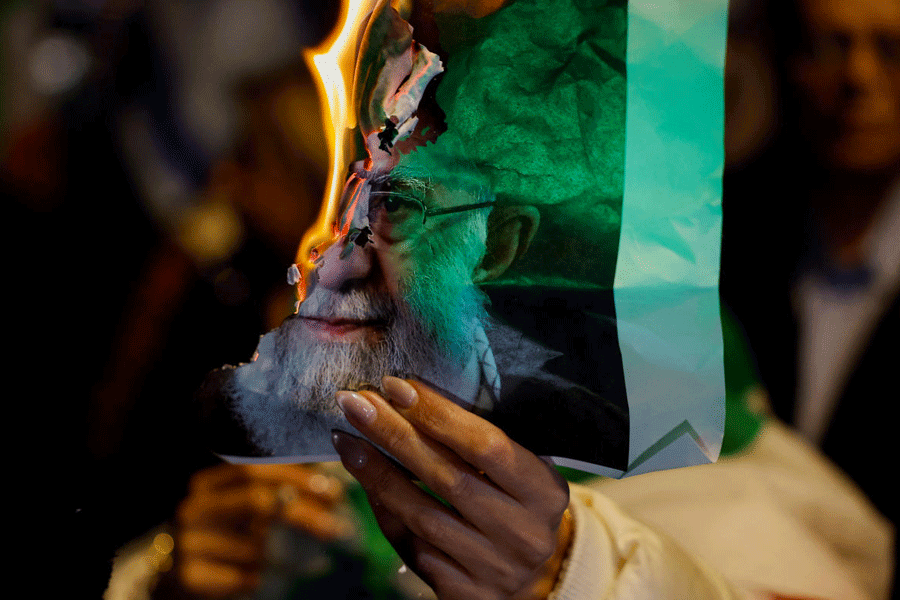 |
 |
 |
| Rituparno Ghosh rehearses Odissi steps at his residence under the watchful eye of exponent Sharmila Biswas. Pictures by Aranya Sen |
After aarekti premer galpo, rituparno ghosh the director is willing to give rituparno ghosh the actor a chance. He has cast himself in chitrangada: the crowning wish that goes on the floors in february. In the morning, it’s the actor you’ll meet in his anwar shah Road residence — practising odissi mudras in front of a door-size mirror. Afternoon onwards, it’s the director we know — brainstorming with his production team on music, costumes, camera, sets.... Rituparno lets T2 in into his new world
The last film you directed was Tagore’s Noukodubi and now you’ve taken up another Tagore story — Chitrangada...
I can go on working on Rabindranath’s works all my life.... I started incorporating Rabindranath into my work since Asukh (1999), though that was indirect. Rabindranath was almost a character in that film, present through images and thoughts. Chokher Bali was my first direct work on Rabindranath. After that I did Noukodubi. I wanted to do Kabuliwala in between. Chitrangada, I would say, is again indirect. I am not using it as a pure text but rather as a reference point, as a core text. We have mostly seen Chitrangada as a very pleasant dance drama.
How does your Chitrangada go?
My Chitrangada is the story of a dancer. I play a choreographer, who plans to stage the dance drama Chitrangada on the occasion of Rabindranath’s 150th birth anniversary. His name is Rudra Chatterjee, pet name Khokon. He studied engineering because that is what his father wanted him to do, but Rudra wanted to do something else and he eventually became a choreographer. It is the same story of conflict as in Rabindranath’s Chitrangada, where the king wants his daughter Chitrangada to become the prince of Manipur since he doesn’t have a son to succeed him. But Chitrangada wants to remain a girl. That’s why the film is called Chitrangada: The Crowning Wish.
In the dance drama that I am choreographing, I play Madan, who in the epic story makes Arjun fall in love with Chitrangada. So in a way, Madan is someone above love. Jisshu (Sengupta) plays a young percussionist, Partha, who wants to join our group. He’s a junkie, has been in rehabilitation, but I take him because I feel he too is marginalised in society. There is a sexual ambivalence in Partha.... And while mentoring him, Partha and I come closer. There is an attachment and then we want to adopt a baby, but since two men can’t adopt a baby in India, I consider becoming a woman in order to be able to adopt a baby. This results in a conflict in Rudra — on whether he is a man or a woman — and he has a nervous breakdown.
You know this whole gay thing had started off as a youth movement. It is looked upon more as a fad, something that one is supposed to get over as one grows up. But no one thinks about what happens to these people once they grow up. They can’t have a blood family, so what do they do? No one gives it a thought.
How would your Rudra be different from your Roop?
Banidi (Basu, author) had pointed out (in t2, January 10) that Aarekti Premer Galpo didn’t explore the versatility of Roop enough to establish that his talent is independent of his sexuality. Well, this is precisely the subject of Chitrangada; this is where Rudra differs from Roop. If you go back to the original story, Chitrangada slowly came into her own, she wanted to be accepted the way she is and she stayed back in Manipur to rule the state. She did not follow Arjun, like Subhadra did. The concept of coming to terms with one’s identity runs through several works of Rabindranath... Chandalika, Chitrangada. Here, Rudra, like Madan, rises above love. As Rudra discovers his versatility, he also resolves his gender identity…. But this story has no connection with Mahesh Dattani’s Dance Like A Man.
The other area where Rudra is different is that he is not effeminate like Roop. He is a virile character. I am not going to dress up like I did as Roop. I will dress up only when I am on stage.
Why did you cast yourself as the protagonist?
I feel I can grow as a director by being an actor. Besides, sometimes I have felt the expressions of my actors to be inadequate. But I needed to assess my acting before casting myself because as a director I had to know if I could bank on my performance. I have done two films on gender sexuality (Aarekti Premer Galpo and Sanjay Nag’s upcoming release Memories in March) and both were with directors who had approached me for those roles. It isn’t as if I wanted to direct a film just because I wanted to act in it. I also considered if I was suitable for the subject I was working on. And honestly, I did not know of any actor who would have gone through the rigorous training of dance, learn it and then recreate it for the film.... I am also playing the narrator in the dance drama.
 |
 |
 |
Why did you cast Jisshu as Partha?
Because I thought he would do it very well. It’s a fantastic role. I wish I was 10 years younger, then I could have done that role!
There’s Raima Sen too and Anjan Dutt for the first time. What do they play?
Raima plays Chitrangada, the warrior princess, in the dance drama. Anjan (Dutt) plays a counsellor whom Rudra goes to after he has a breakdown.... Dipankar De plays Rudra’s father.
But why Anjan?
Because I felt with his age, there’s a sense of wisdom about him now, and he’s a good actor. The story is recreated through my conversations with him. The film is very interesting structurally. It’s not linear. My character is an observer; he is more like Bhootnath of Saheb Bibi Golam.
Tell us about the dance drama you’re planning for the film…
The dance drama will be miniaturist and minimalist in style. We are doing the costumes in Madam Menaka’s (dancer-choreographer of the 1930s) Oriental style. The stage is black and the hospital (where Rudra is admitted after the breakdown) will be a clinical grey. The stage will be used as a language. For instance, we will use the spotlight. The stage is an emotional space here.
But don’t think it is a cerebral film. There’s going to be high-voltage drama! This film raises a lot of questions about sexuality without getting into eroticism. The text that Rudra is working on becomes his life. That is why, for me, Chitrangada: The Crowning Wish is an indirect tribute to Rabindranath.
Have there been any influences of Uday Shankar in conceiving this film?
For me, dance is more a visual art than a performing art. That’s how I have grown up since my parents were painters. I have grown up watching postures, colours, frames. I wouldn’t actually be able to differentiate between good dance and bad dance. So, if there is any influence of Uday Shankar, then it is on Rituparno and not on Rudra.... I am going to dedicate this film to my parents.
You’ve chosen Odissi, not Manipuri, for the dance drama…
That’s because the Manipur that Arjun visited was a part of Kalinga in Orissa. Chitrangada was not the princess of Manipur the state as we usually think she is. All Chitrangada dance dramas will inevitably have a girl dancing in the Manipuri costume.
You are going through a rigorous schedule to pick up Odissi...
I have been training under Sharmiladi (Biswas) for the past three months, though there was a break in between after I tore a ligament. You could say, I am dancer in the morning and a director in the afternoon (laughs)…. Anjan gave me a good piece of advice. He told me to observe what a dancer does, how he behaves, more than burn all my energy in learning dance. My aim is not to impress people with my dance... Rituparno ki phatiye nachlo, sheta noy… You have to come across as a dancer on screen. When I did Unishe April, the actress didn’t seem to be a dancer.... Dancers talk at the top of their voice because they are used to teaching a class full of people. They do exaggerated movements. They sit down and get up in a certain manner. These are very important, which I am trying to pick up.
Did you ever learn dance?
No, never but I was confident about it. I don’t want to be dainty and graceful; I want to be a dancer.
Do you think juggling acting and directing is going to be easy?
Not at all, it’s going to be very difficult. But I have Sanjay (Nag) as my associate director.
Chitrangada will mark the return of the Rituparno-Shree Venkatesh Films team after seven years...
Yes. I am co-presenting Memories in March with Venkatesh. Actually I was thinking of directing Memories in March but Shrikant (Mohta) said, ‘You have done a lot of chamber dramas, do something different.’ I told him about Chitrangada and he agreed immediately. I will have my old team back with Chitrangada. Venkatesh apart, there will be Arghya (Arghyakamal Mitra, editor), Avik (Mukhopadhyay, DoP), Debu (Debojyoti Mishra, composer), Chinku (Indranil Ghosh, art director)...
 |
| Debojyoti and Rituparno discuss the film’s music. (Aranya Sen) |
The soundtrack of Chitrangada will have the feel of world music. We are not looking at an European sound; we had done it in Chokher Bali. Peter Brook’s Mahabharat, where he had used a Japanese composer, is a huge inspiration for me. We have used several songs from Tagore’s Chitrangada, which includes Bodhu kon alo and Rodonobhora e basanta. Kaushiki Desikan and Srikanta Acharya will do the playback. It will be improvised music. I will use the saxophone, Latin percussion, oboe and the Algerian cello. Among Indian instruments, we will have the veena and pakhwaj. Some Algerian and Canadian musicians are working with us on this.
— Debojyoti Mishra, composer










